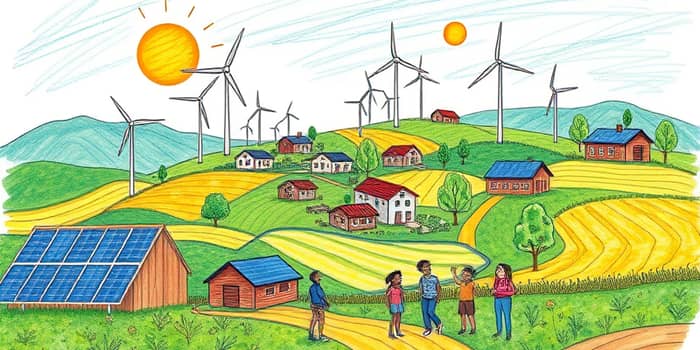The concept of a green economy represents a profound shift toward development that nurtures both people and planet. By embracing sustainability at its core, this model offers a pathway to economic resilience, social inclusion, and environmental stewardship. This article explores the evolution, principles, policy tools, and practical opportunities of the green economy, guiding readers toward actionable strategies for driving meaningful change.
Definition and Historical Evolution
The United Nations Environment Programme defines a green economy as one that is low carbon, resource efficient, and socially inclusive. At its heart, it prioritizes environmental risk reduction, ecological sustainability, and equitable growth. Rather than measuring success through GDP alone, it emphasizes human well-being and the health of natural systems.
The term emerged in 1989 with the UK Government’s landmark report, "Blueprint for a Green Economy." Throughout the early 1990s, environmental economists expanded its scope to address global challenges such as climate change, resource depletion, and biodiversity loss. Over decades, the green economy has matured into a comprehensive framework guiding policy, investment, and community action worldwide.
Traditional vs Green Economic Models
Traditional economic models often prioritize short-term gains, overlooking the lasting impact of resource exploitation and pollution. In contrast, green approaches seek a balance between economic development and environmental conservation, acknowledging that healthy ecosystems underpin long-term prosperity.
- Traditional economies often overlook long-term ecological impacts.
- Green models integrate sustainability into core policies.
- Finite nature of natural resources demands stewardship.
Core Principles and Pillars of the Green Economy
The green economy rests on four intertwined pillars:
- Low-carbon energy and resource use
- Social equity and inclusive growth
- Biodiversity protection and restoration
- Circular economy initiatives like recycling
Together, these principles drive a holistic vision that aligns consumption and production with ecological boundaries, while ensuring that all communities share in the benefits of progress.
Policy Instruments for Enabling the Green Economy
Effective transition demands bold policy action. Governments and institutions are reorienting investments, subsidies, pricing, and regulations to reflect true environmental and social costs. Key tools include carbon pricing mechanisms, renewable energy incentives, green taxation, and strict environmental standards.
For instance, carbon taxes discourage high-emission activities, while feed-in tariffs and production credits accelerate the deployment of clean energy. Green bonds and sustainable finance frameworks guide private capital toward projects that deliver positive environmental returns.
Major Growth Sectors
Several sectors stand at the forefront of green growth opportunities:
Renewable Energy: Solar, wind, hydro, and bioenergy technologies are rapidly scaling up. Advances in storage and grid integration are unlocking new potentials, with millions of jobs expected as capacity expands.
Green Infrastructure: Sustainable transport systems, energy-efficient buildings, smart grids, and water management projects not only reduce emissions but also improve quality of life in urban and rural areas.
Sustainable Agriculture: Regenerative farming, agroforestry, and precision agriculture boost yields, conserve soil health, and strengthen food security. Local food chains and waste reduction practices further drive resilience.
Carbon Markets and Nature-Based Solutions: Reforestation, wetland restoration, and carbon capture projects create both environmental benefits and new revenue streams, fostering community engagement in conservation.
Economic and Social Opportunities
The green transition is a powerful engine for job creation and poverty reduction. UNEP estimates millions of new jobs globally by 2030 in clean energy, construction, and ecosystem restoration. These roles often feature higher safety standards and skill premiums, uplifting workers and communities.
Inclusive green strategies also address social disparities by ensuring access to training, resources, and finance for marginalized groups. By promoting local entrepreneurship and cooperatives, regions can build resilience and reduce vulnerability to economic shocks, becoming resilient to climate-related disasters and shocks.
Key Numbers and Growth Projections
Data-driven insights underscore the scale of opportunity. Leading institutions predict hundreds of billions in green bond issuance, while job projections climb to tens of millions across sectors.
These figures demonstrate that every dollar invested in green solutions can yield multiple dollars in economic, social, and ecological returns, reinforcing the case for ambitious action.
Challenges and Pathways for Successful Transformation
Despite clear benefits, the green transition faces systemic barriers. Regions dependent on fossil fuels grapple with initial capital requirements and social costs, while emerging markets require technical support and financing to leapfrog high-emission pathways.
Strong governance is crucial. Only through evidence-based integrated institutions ensure transparency and public participation can policy coherence be maintained, vested interests be balanced, and fair transition measures be implemented.
Ongoing debates around green growth versus degrowth highlight the need for nuanced approaches. Emphasizing both efficiency and sufficiency, societies must tailor strategies to local contexts, ensuring that progress honors planetary boundaries without compromising human dignity.
Conclusion and Global Outlook
The green economy offers a transformative blueprint for achieving the Sustainable Development Goals and securing a prosperous future for all. While challenges remain, the convergence of innovation, finance, and policy presents an unparalleled chance to reshape our world.
By championing coordinated policy, investment, and governance reforms, individuals, businesses, and governments can unlock sustainable growth, climate resilience, and social well-being. The journey ahead demands vision, collaboration, and unwavering commitment—but the rewards promise a thriving planet and inclusive prosperity for generations to come.
References
- https://www.unep.org/regions/asia-and-pacific/regional-initiatives/supporting-resource-efficiency/green-economy
- https://greenly.earth/en-us/blog/company-guide/green-economy--meaning-and-principles
- https://www.greeneconomycoalition.org/news-and-resources/the-5-principles-of-green-economy
- https://www.masterclass.com/articles/green-economy
- https://stata-brazil.com/blog/the-green-economy-can-sustainable-investments-drive-growth.html
- https://www.frontiersin.org/journals/environmental-science/articles/10.3389/fenvs.2022.870271/full
- https://sustainabledevelopment.un.org/index.php?menu=1447










